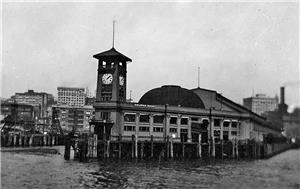On April 25, 1912, on the Seattle waterfront, the Alaska Steamship liner Alameda rams the Colman Dock, topples the dock's clock tower, sinks the stern wheel steamboat Telegraph, and injures five women. Colman Dock (today the Washington State Ferries dock) is located in Elliott Bay in Seattle between Madison and Marion streets.
Engine Room Error
The tragedy struck shortly before 10:30 p.m., just after the Alameda had taken on a load of fuel at the Standard Oil dock in the East Waterway. As the steamship approached Pier 2, Captain John A. O'Brien (1851-1931) ordered full speed astern, but Second Assistant Engineer Robert Bunton mistook the signal for full speed ahead. The vessel zoomed past Pier 2 and bore down on Colman Dock. Captain O'Brien realized the engine room error almost immediately and ordered the anchors out in hopes of slowing the vessel.
Over a dozen people were inside the Colman Dock waiting room, biding their time until the next ferry arrived. Some read newspapers, looking at the latest stories about the Titanic, which had sunk in the north Atlantic 10 days earlier. Police Patrolman O. J. Larsen stood at the end of the wharf, looking out over the water.
Seeing that the Alameda was heading towards Colman Dock at full speed, Larsen ran through the waiting room, shouting the alarm. The waiting passengers looked out the big windows and saw the Alameda heading straight for them. As they ran back through the building, the Alameda struck hard, splintering wood and sending shards of glass everywhere.
As the vessel tore through the dock, the great clock tower above the waiting room came crashing down, directly on top of the steamer's bow. This slowed the vessel, but did not stop it. As the Alameda ripped through the dock's wreckage, it plowed directly into the sternwheeler Telegraph, which was docked in the north slip. The Telegraph's crew jumped to safety as their ship was split almost in half. Within 15 minutes, the Telegraph sank below the waves, in eight fathoms of water. The Alameda ended up near the Grand Trunk Dock, 600 feet north of Colman Dock.
Aftermath
Inside Colman Dock, help was given to the injured. One woman broke her ankle while trying to escape while others suffered cuts and bruises from flying glass and splinters. Outside, searchers looked in the waters to rescue anyone who had fallen in.
The Ferry Sioux, which had slowed its course to allow the Alameda to pass, dropped lifeboats into the water to search the wreckage for injured persons. Had the Sioux arrived at the dock five minutes earlier, it would have been in the path of the Alameda, endangering the lives of its 60 passengers.
The next day, crowds thronged to the waterfront to survey the damage. The clock tower, which had rolled of the top of the Alameda, was now floating out in Elliott Bay. Tugs hauled it over to the beach at West Seattle in the hopes that the clock could be repaired.
Over $50,000 of damage was done to Colman Dock, and work started almost immediately on repairs. Amazingly, the Alameda suffered only $900 in damage, and after a few hours of repairs, the ship sailed for Alaska, only 12 hours behind schedule. The Telegraph was raised and later repaired. Its owners sued the owners of the Alameda for $55,000 in damages, but received only $45,000.
Cheers and Jeers
Captain O'Brien was praised for his efforts in saving the Alameda, noting that if he had not ordered the anchors dropped, the steamer could have heavily damaged the Grand Trunk also. Fellow captain Howard Bullene, master of the steamer Santa Ana told The Seattle Times, "If the navigator of the wrecked Titanic had exhibited half the presence of mind of Captain O'Brien, the most frightful accident in maritime history would have been averted" (The Seattle Times, April 29, 1912).
Full blame for the accident fell on Second Assistant Engineer Robert Bunton and Third Assistant Engineer Guy Can Winter (1884-1940). Bunton had his license suspended for two months, and Van Winter had his suspended for 30 days. Federal investigators declared that they were unable to understand how the two men could have lapsed so far into apparent apathy that they couldn't notice their error until it was too late.
The Colman Clock, built in 1908, was repaired and replaced in a new tower at Colman Dock. The clock was taken down in 1936 when Colman Dock was rebuilt, and was put into storage. There it remained for years until being rediscovered in 1976. It was restored in 1984 and placed back on the dock. Today (2012) the clock sits near the street side of the ferry terminal, still keeping time.

